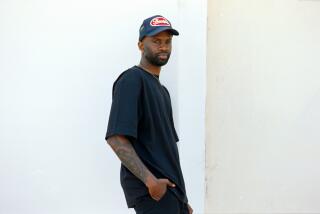Real life shows its true colors
- Share via
PHILADELPHIA — It might be hard for visitors to look at the gorgeous images on view in the new “Mavericks of Color” exhibit at the Philadelphia Museum of Art and understand the criticism they once spurred.
Vulgar. Garish. Lurid. That’s what living legends such as Walker Evans and Edward Steichen said in the 1960s of the work by young pioneers of color photography. When it came to photography, what constituted high art to the cognoscenti was a purely black-and-white issue.
The show of about 50 works owned by the museum, some never before shown to the public, pays homage to four Americans who broke the “color barrier” in photography: William Christenberry, William Eggleston, Joel Meyerowitz and Eliot Porter.
“These were the guys who cracked it open,” curator Katherine Ware said. “They were really testing the ranges of what they could do with the medium.”
Some critics simply disliked the look of color, dismissing such work as akin to commercial photography or simple snapshots. Others took issue with what they saw as a lack of composition and the humble subject matter -- such as Eggleston’s bare bulb against a red ceiling or Christenberry’s ramshackle country stores and gas stations, captured with a Brownie camera.
“People were asking, ‘What makes this art? ... It looks too much like reality,’ ” Ware said.
The color street scenes and still lifes certainly look more “real” than the exacting works of black-and-white masters such as Evans and Ansel Adams. However, it’s clear in such works as Porter’s lush lichens and seaweed compositions from 1972’s Iceland portfolio and his “how-did-he-do-that?” bird photos from 1976’s “Birds in Flight” series: These have little in common with mere snapshots.
Meyerowitz’s 1976 snow scene in the show has a title -- “From the Car, New York State” -- that makes it sound like an off-the-cuff snap. But the eerie whitish blues of the photo’s billboard, pine trees and ground create a mood that isn’t accidental.
“Color has such a specific resonance of time and memory. Colors have connotations; they can bring back memories of childhood,” said Meyerowitz. He is known for his 1978 Cape Cod book, “Cape Light,” which has sold more than 100,000 copies.
Eggleston’s 1976 solo show at the Museum of Modern Art in New York marked a breakthrough step toward recognition of color photography in the art world -- but bias toward black and white still exists.
When Meyerowitz was chosen by the Museum of the City of New York after the 9/11 terrorist attacks to visually document the devastation and the weeks of heroic work that followed, he said some people asked him why he didn’t use black-and-white film.
“You don’t see tragedy in black and white, you see tragedy in color,” he said. “That tragedy happened on a beautiful fall day.”
“Mavericks of Color: Photographs From the Collection” runs through Nov. 27.
More to Read
The biggest entertainment stories
Get our big stories about Hollywood, film, television, music, arts, culture and more right in your inbox as soon as they publish.
You may occasionally receive promotional content from the Los Angeles Times.










